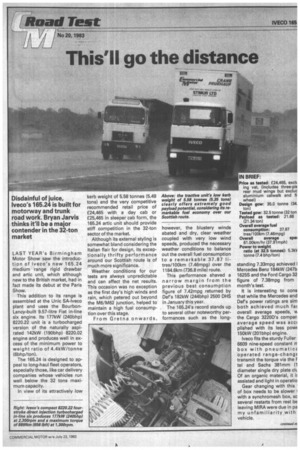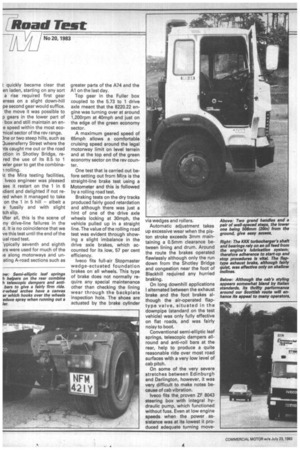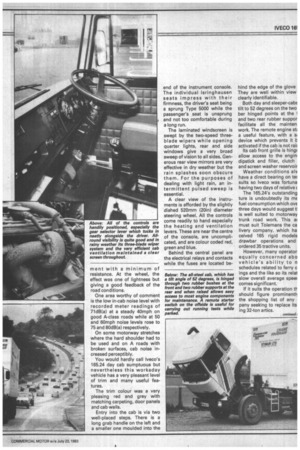This II go the distance
Page 49

Page 50

Page 51

If you've noticed an error in this article please click here to report it so we can fix it.
LAST YEAR's Birmingham Motor Show saw the introduction of Iveco's new 165.24 medium range rigid drawbar and artic unit, which although new to the British market, had in fact made its debut at the Paris Show.
This addition to its range is assembled at the Unic SA-Iveco plant and uses the BourbonLancy-built 9.57-litre Fiat in-line six engine. Its 177kW (240bhp) 8220.22 unit is a turbocharged version of the naturally aspirated 142kW (190bhp) 8220.02 engine and produces well in excess of the minimum power to weight ratio of 4.4kW/tonne (6bhp/ton).
The 165.24 is designed to appeal to long-haul fleet operators, especially those, like car delivery companies whose vehicles run well below the 32 tons maximum capacity.
In view of its attractively low kerb weight of 5.58 tonnes (5.49 tons) and the very competitive recommended retail price of £24,465 with a day cab or £25,465 in sleeper cab form, the 165.24 artic unit should provide stiff competition in the 32-ton sector of the market.
Although its external styling is somewhat bland considering the Italian flair for design, its exceptionally thrifty performance around our Scottish route is of much more significance.
Weather conditions for our tests are always unpredictable and can affect the net results. This occasion was no exception as the first day's high winds and rain, which petered out beyond the M6/M62 junction, helped to maintain a high fuel consumption over this stage.
From Gretna onwards, however, the blustery winds abated and dry, clear weather coupled with very low wind speeds, produced the necessary weather conditions to balance out the overall fuel consumption to a remarkable 37.87 litres/100km (7.46mpg) over the 1184.6km (736.8 mile) route.
This performance shaved a narrow margin from the previous best consumption figure of 7.42mpg returned by Oaf's 182kW (244bhp) 2500 DHS in January this year.
. The 165.24's record stands up to several other noteworthy performances such as the long standing 7.33mpg achieved I Mercedes Benz 184kW (247b 1625S and the Ford Cargo 32 figure of 7.38mpg from month's test.
It is interesting to cons that while the Mercedes and Des power ratings are sim both achieved much fa: overall average speeds, v% the Cargo 3220D's compar. average speed was acc( plished with its less powE 150kW (201bhp) engine.
lveco fits the sturdy Fuller 6609 nine-speed constant rr box with pneumatics operated range-changE transmit the torque via the F tel and Sachs 381mm (1 diameter single dry plate ch. Of an organic material, it it assisted and light in operatio Gear changing with this of box needs to be slower I with a synchromesh box, so several restarts from rest be leaving MIRA were due in pa my unfamiliarity with vehicle, t quickly became clear that en laden, starting on any sort a rise required first gear ereas on a slight down-hill pe second gear would suffice. the move it was possible to p gears in the lower part of box and still maintain an ene speed within the most eco-nical sector of the rev range. )ne or two steep hills, such as aueensferry Street where the its caught me out or the road ction in Shotley Bridge, rered the use of its 8.5 to 1 wler gear to get the combinarolling.
kt the Mira testing facilities, lveco engineer was pleased sec it restart on the 1 in 6 [client and delighted if not re(ed when it managed to take on the 1 in 5 hill — albeit a e fussily and with slight tch slip.
l‘fter all, this is the scene of fly drive-line failures in the .5t. It is no coincidence that we ve this test until the end of the ual road test.
-ypically seventh and eighth )rs were used for much of the le along motorways and unating A-road sections such as
greater parts of the A74 and the Al on the last day.
Top gear in the Fuller box coupled to the 5.73 to 1 drive axle meant that the 8220.22 engine was turning over at around 1,200rpm at 40mph and just on the edge of the green economy sector.
A maximum geared speed of 65mph allows a comfortable cruising speed around the legal motorway limit on level terrain and at the top end of the green economy sector on the rev counter.
One test that is carried out before setting out from Mira is the straight-line brake test using a Motometer and this is followed by a rolling road test.
Braking tests on the dry tracks produced fairly good retardation and although there was just a hint of one of the drive axle wheels locking at 30mph, the vehicle pulled up in a straight line. The value of the rolling road test was evident through showing a slight imbalance in the drive axle brakes, which accounted for its low, 57 per cent efficiency.
Iveco fits full-air Stopmaster wedge-actuated foundation brakes on all wheels. This type of brake does not normally require any special maintenance other than checking the lining wear through the backplate inspection hole. The shoes are actuated by the brake cylinder via wedges and rollers.
Automatic adjustment takes up excessive wear when the piston stroke exceeds 3mm maintaining a 0.5mrn clearance between lining and drum. Around the route the brakes operated flawlessly although only the run down from the Shotley Bridge and congestion near the foot of Blackhill recjuired any hurried braking.
On long downhill applications I alternated between the exhaust brake and the foot brakes although the air-operated flaptype valve, situated in the downpipe (standard on the test vehicle) was only fully effective on flat roads, and was fairly noisy to boot.
Conventional semi-elliptic leaf springs, telescopic dampers allround and anti-roil bars at the rear, help to produce a quite reasonable ride over most road surfaces with a very low level of cab pitch.
On some of the very severe stretches between Edinburgh and Darlington, however, it was very difficult to make notes because of cab vibration.
lveco fits the proven ZF 8043 steering box with integral hydraulic pump, which functioned without fuss. Even at low engine speeds when the power assistance was at its lowest it produced adequate turning move ment with a minimum of resistance. At the wheel, the effect was one of lightness but giving a good feedback of the road conditions.
One area worthy of comment is the low in-cab noise level with recorded meter readings of 71dB(a) at a steady 40mph on good A-class roads while at 50 and 60mph noise levels rose to 75 and 80dB(a) respectively.
On some motorway stretches where the hard shoulder had to be used and on A roads with broken surfaces, cab noise increased perceptibly.
You would hardly call lveco's 165.24 day cab sumptuous but nevertheless this workaday vehicle has a very pleasant level of trim and many useful features.
The trim colour was a very pleasing red and grey with matching carpeting, door panels and cab walls.
Entry into the cab is via two well-placed steps. There is a long grab handle on the left and a smaller one moulded into the end of the instrument console. The individual lsringhausen seats impress with their firmness, the driver's seat being a sprung Type 5000 while the passenger's seat is unsprung and not too comfortable during a long run.
The laminated windscreen is swept by the two-speed threeblade wipers while opening quarter lights, rear and side windows give a very broad sweep of vision to all sides. Generous rear view mirrors are very effective in dry weather but the rain splashes soon obscure them. For the purposes of dealing with light rain, an intermittent pulsed sweep is essential.
A clear view of the instruments is afforded by the slightly 'dished 520mm (20in) diameter steering wheel. All the controls come readily to hand especially the heating and ventilation levers. These are near the centre of the console, are uncomplicated, and are colour coded red, green and blue.
Behind the central panel are the electrical relays and contacts while the fuses are located be hind the edge of the glove They are well within view clearly identifiable.
Both day and sleeper-cabE tilt to 52 degrees on the two ber hinged points at the and two rear rubber suppor facilitate all the mainten work. The remote engine sti a useful feature, with a s; device which prevents it b activated if the cab is not rai:
Its cab front grille is hing( allow access to the engin, dipstick and filler, clutch and screen washer reservoir
Weather conditions alv have a direct bearing on te; suits so lveco was fortuna having two days of relative The 165.24's outstanding ture is undoubtedly its ME fuel consumption which OVE three days would suggest ti is well suited to motorway trunk road work. This a: must suit Tolemans the ca livery company, which ha ceived 165 rigid models drawbar operations and ordered 35 tractive units.
However, many operator equally concerned abo vehicle's ability to n schedules related to ferry c ings and the like so its relai slow overall average speec comes significant.
If it suits the operation t1 should figure prominentl the shopping list of any pany seeking to replace its ing 32-ton a rtiCS.




















































































